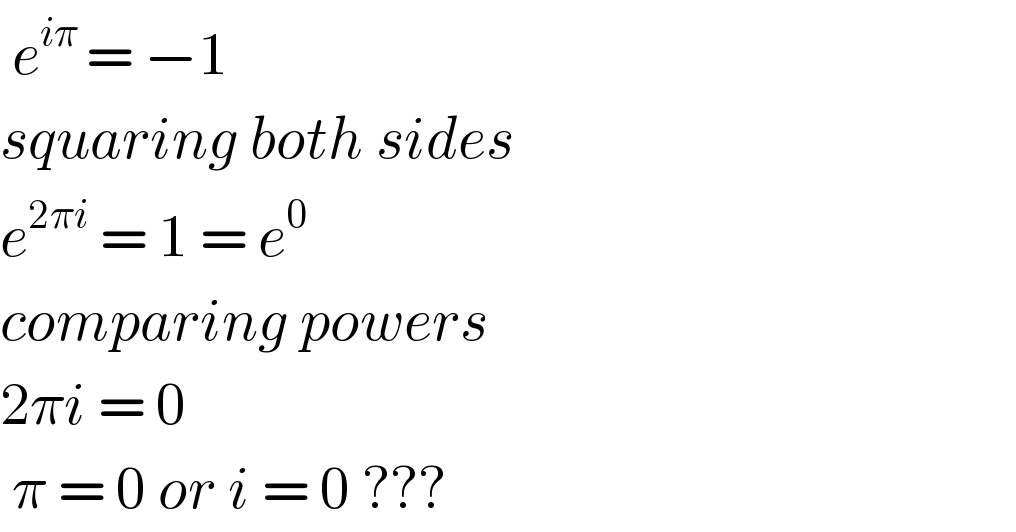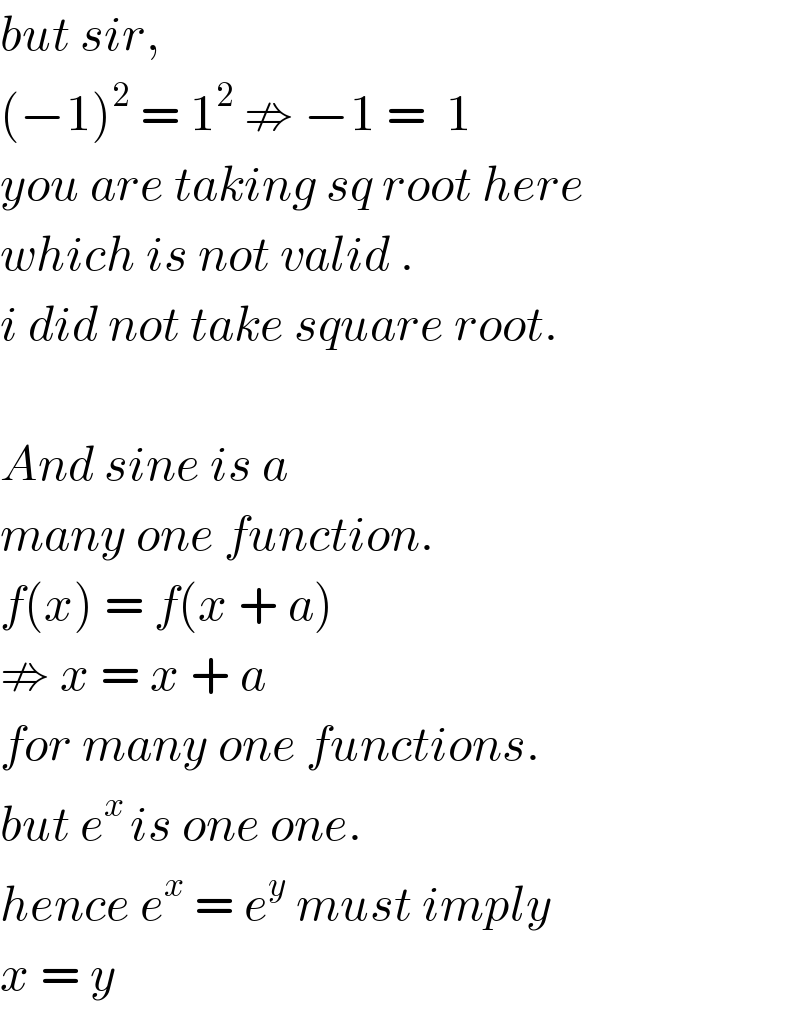Question Number 33473 by 33 last updated on 17/Apr/18

$$\:{e}^{{i}\pi\:} =\:−\mathrm{1} \\ $$$${squaring}\:{both}\:{sides} \\ $$$${e}^{\mathrm{2}\pi{i}} \:=\:\mathrm{1}\:=\:{e}^{\mathrm{0}} \\ $$$${comparing}\:{powers} \\ $$$$\mathrm{2}\pi{i}\:=\:\mathrm{0} \\ $$$$\:\pi\:=\:\mathrm{0}\:{or}\:{i}\:=\:\mathrm{0}\:??? \\ $$
Commented by abdo imad last updated on 17/Apr/18
![look sir the fonction R→]0,+∞[ /f(x)=e^x is abijection from R to ]0,+∞[ for that we have e^x =e^y ⇔ x=y but the function R →C / g(x) =e^(ix) is not a bijection and e^(ix) =e^(iy) ⇔ x =y +2kπ with k ∈ Z and if z =r e^(iθ) ,r>0 ln(z) = lnr +i(θ +2kπ) but we take only ln(z)=lnr +iθ as a principal determination of the complex logarithme .](https://www.tinkutara.com/question/Q33480.png)
$$\left.{look}\:{sir}\:{the}\:{fonction}\:{R}\rightarrow\right]\mathrm{0},+\infty\left[\:/{f}\left({x}\right)={e}^{{x}} \:\:{is}\:{abijection}\right. \\ $$$$\left.{from}\:{R}\:{to}\:\right]\mathrm{0},+\infty\left[\:{for}\:{that}\:{we}\:{have}\:{e}^{{x}} \:={e}^{{y}} \:\:\Leftrightarrow\:{x}={y}\:\right. \\ $$$${but}\:{the}\:{function}\:{R}\:\rightarrow{C}\:\:/\:{g}\left({x}\right)\:={e}^{{ix}} \:{is}\:{not}\:{a}\:{bijection}\:{and} \\ $$$${e}^{{ix}} \:={e}^{{iy}} \:\:\Leftrightarrow\:{x}\:={y}\:+\mathrm{2}{k}\pi\:\:{with}\:{k}\:\in\:{Z}\:{and}\:{if}\:{z}\:={r}\:{e}^{{i}\theta} \:\:,{r}>\mathrm{0} \\ $$$${ln}\left({z}\right)\:=\:{lnr}\:+{i}\left(\theta\:+\mathrm{2}{k}\pi\right)\:{but}\:{we}\:{take}\:{only} \\ $$$${ln}\left({z}\right)={lnr}\:\:+{i}\theta\:\:{as}\:{a}\:{principal}\:{determination}\:{of}\:{the} \\ $$$${complex}\:{logarithme}\:. \\ $$
Commented by Joel578 last updated on 17/Apr/18

$$\mathrm{Same}\:\mathrm{like}\:\:\mathrm{sin}\:\pi\:=\:\mathrm{sin}\:\mathrm{0} \\ $$$$\mathrm{then}\:\pi\:=\:\mathrm{0}\:?? \\ $$$$\mathrm{Or}\:\left(−\mathrm{1}\right)^{\mathrm{2}} \:=\:\mathrm{1}^{\mathrm{2}} \\ $$$$\mathrm{then}\:−\mathrm{1}\:=\:\mathrm{1}\:?? \\ $$$$\mathrm{Guess}\:\mathrm{why}\:\mathrm{it}'\mathrm{s}\:\mathrm{incorrect} \\ $$
Commented by 33 last updated on 17/Apr/18

$${but}\:{sir},\: \\ $$$$\left(−\mathrm{1}\right)^{\mathrm{2}} \:=\:\mathrm{1}^{\mathrm{2}} \:\nRightarrow\:−\mathrm{1}\:=\:\:\mathrm{1} \\ $$$${you}\:{are}\:{taking}\:{sq}\:{root}\:{here} \\ $$$${which}\:{is}\:{not}\:{valid}\:. \\ $$$${i}\:{did}\:{not}\:{take}\:{square}\:{root}. \\ $$$$ \\ $$$${And}\:{sine}\:{is}\:{a} \\ $$$${many}\:{one}\:{function}. \\ $$$${f}\left({x}\right)\:=\:{f}\left({x}\:+\:{a}\right) \\ $$$$\nRightarrow\:{x}\:=\:{x}\:+\:{a}\: \\ $$$${for}\:{many}\:{one}\:{functions}. \\ $$$${but}\:{e}^{{x}\:} {is}\:{one}\:{one}. \\ $$$${hence}\:{e}^{{x}} \:=\:{e}^{{y}} \:{must}\:{imply} \\ $$$${x}\:=\:{y} \\ $$
Answered by MJS last updated on 17/Apr/18
![you can′t compare the powers in this case, because e^(ϕi) is a periodic function z=a+bi=r(cos ϕ+isin ϕ)=re^(ϕi) [with r=abs(z)=(√(a^2 +b^2 )) and ϕ=tan^(−1) (b/a)] because sin ϕ and cosϕ are periodic it should be clear that for n∈N_0 z=r(cos(ϕ±2nπ)+isin(ϕ±2nπ)) ⇒ ⇒ z=re^(ϕ±2nπ) therefore, e^0 =e^(2πi) ⇏ 0=2πi but you made another mistake: x^y =−1 ∣^2 x^(2y) =1 x^(2y) =x^0 2y=0 y=0 BUT x^0 ≠−1 ⇒ squaring both sides might lead to wrong results](https://www.tinkutara.com/question/Q33477.png)
$$\mathrm{you}\:\mathrm{can}'\mathrm{t}\:\mathrm{compare}\:\mathrm{the}\:\mathrm{powers} \\ $$$$\mathrm{in}\:\mathrm{this}\:\mathrm{case},\:\mathrm{because}\:{e}^{\varphi{i}} \:\mathrm{is}\:\mathrm{a} \\ $$$$\mathrm{periodic}\:\mathrm{function} \\ $$$${z}={a}+{bi}={r}\left(\mathrm{cos}\:\varphi+{i}\mathrm{sin}\:\varphi\right)={re}^{\varphi{i}} \\ $$$$\:\:\:\:\:\:\:\:\:\:\left[\mathrm{with}\:{r}=\mathrm{abs}\left({z}\right)=\sqrt{{a}^{\mathrm{2}} +{b}^{\mathrm{2}} }\right. \\ $$$$\left.\:\:\:\:\:\:\:\:\:\:\:\:\mathrm{and}\:\varphi=\mathrm{tan}^{−\mathrm{1}} \:\frac{{b}}{{a}}\right] \\ $$$$\mathrm{because}\:\mathrm{sin}\:\varphi\:\mathrm{and}\:\mathrm{cos}\varphi\:\mathrm{are}\:\mathrm{periodic} \\ $$$$\mathrm{it}\:\mathrm{should}\:\mathrm{be}\:\mathrm{clear}\:\mathrm{that}\:\mathrm{for}\:{n}\in\mathbb{N}_{\mathrm{0}} \\ $$$${z}={r}\left(\mathrm{cos}\left(\varphi\pm\mathrm{2}{n}\pi\right)+{i}\mathrm{sin}\left(\varphi\pm\mathrm{2}{n}\pi\right)\right)\:\Rightarrow \\ $$$$\Rightarrow\:{z}={re}^{\varphi\pm\mathrm{2}{n}\pi} \\ $$$$ \\ $$$$\mathrm{therefore},\:{e}^{\mathrm{0}} ={e}^{\mathrm{2}\pi{i}} \:\nRightarrow\:\mathrm{0}=\mathrm{2}\pi{i} \\ $$$$ \\ $$$$\mathrm{but}\:\mathrm{you}\:\mathrm{made}\:\mathrm{another}\:\mathrm{mistake}: \\ $$$${x}^{{y}} =−\mathrm{1}\:\mid^{\mathrm{2}} \\ $$$${x}^{\mathrm{2}{y}} =\mathrm{1} \\ $$$${x}^{\mathrm{2}{y}} ={x}^{\mathrm{0}} \\ $$$$\mathrm{2}{y}=\mathrm{0} \\ $$$${y}=\mathrm{0} \\ $$$$\boldsymbol{\mathrm{BUT}}\:{x}^{\mathrm{0}} \neq−\mathrm{1} \\ $$$$\Rightarrow\:\mathrm{squaring}\:\mathrm{both}\:\mathrm{sides}\:\mathrm{might} \\ $$$$\mathrm{lead}\:\mathrm{to}\:\mathrm{wrong}\:\mathrm{results} \\ $$
Commented by 33 last updated on 17/Apr/18

$${haha}\:{very}\:{apt}\:{explanation} \\ $$$${sir}.\:{thanks}\:{for}\:{your} \\ $$$${effort}. \\ $$
